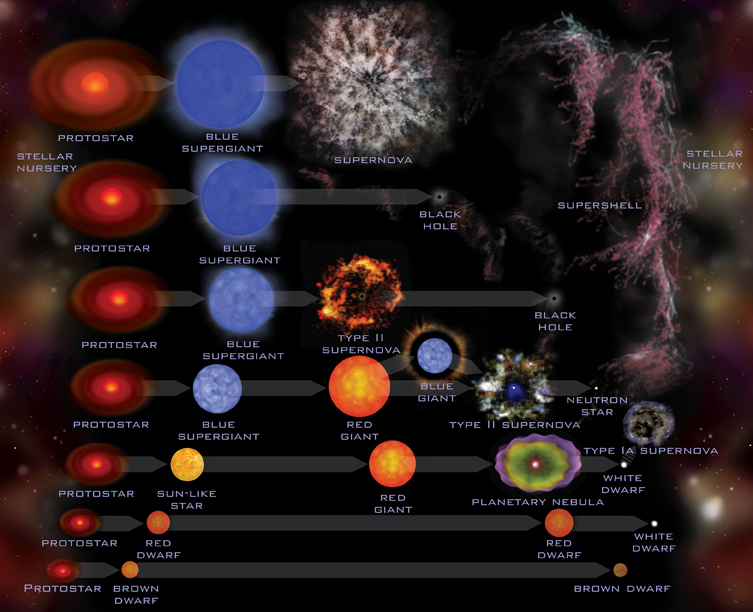It looks like you're using an Ad Blocker.
Please white-list or disable AboveTopSecret.com in your ad-blocking tool.
Thank you.
Some features of ATS will be disabled while you continue to use an ad-blocker.
share:
If the light just reached us, and the 'debris' travelled at 10% (or 1/10) the speed of light, the debris would take 10 times as long and thus 120 million years to reach us. So it seems we have around 108 million years to wait for the debris.
Beavers
reply to post by proob4
The light took 12 million years already and has just hit us.
If the debris travelled at 10% of the speed of light, the answer would be something along the lines of 10.8 million years.
I just don't know how fast it travels..
edit on 1/22/2014 by abecedarian because: (no reason given)
It will never reach us. Any massive particles will most likely never reach the escape velocity of its parent galaxy. It will continue to circle the
galaxy and some of it will go on to make new stars and planets.
reply to post by nitetrain
Making a mental note to ask my astronomy professor whether there is debris or not, and where gold comes from.
Making a mental note to ask my astronomy professor whether there is debris or not, and where gold comes from.
Beavers
reply to post by nofear39
12 million years have already passed.
So another 10.8 million years from now if 10% is correct...
More like 108 million years if it travels at 10% the speed of light and it took 12 million for the light to reach us,
Beavers
reply to post by boncho
I hadn't thought of that, I just assumed it would explode 360 degrees and at least something would come our way (eventually) but you make a good point.
I'm still interested in the estimated speed if you find anything!
It's irrelevant because that's not how it work. But in case you're wonder debris from a supernova would not travel at even .001% of the speed of light. And even that slows down further as it encounters the interstellar medium and other particles.
Here's a helpful graphic on stellar evolution. What a supernova leaves behind is a planetary nebula or in some cases, a stellar nursery. As you can see, death leads to new life.

edit on 28-1-2014 by JadeStar because: (no reason given)
edit on 28-1-2014 by JadeStar because: (no reason given)
InhaleExhale
Beavers
reply to post by nofear39
12 million years have already passed.
So another 10.8 million years from now if 10% is correct...
More like 108 million years if it travels at 10% the speed of light and it took 12 million for the light to reach us,
Math in this thread has been atrocious. Yours is correct (star for that) but the premise of the whole thread is wrong since this stuff will never reach the solar system in any significant way for a number of reasons which include interactions with the interstellar medium.
Even if it did somehow manage to escape such physical interactions.......
Such debris doesn't travel at 10% of the speed of light more like .001% of the speed of light or approx 670,000,000 kilometers per hour (approx 416,000,000 miles per hour). This is basic astronomy.
That would be 1,080,000 million years (1,080 Billion Years) or 1.08 TRILLION years from now...
The Sun will have long since died, it will go off the main sequence in about 4-5 billion years from now, entering red giant phase.
The universe itself will likely cease to exist by then with most theories having the universe ending in another 15-20 billion years.
edit on
28-1-2014 by JadeStar because: (no reason given)
new topics
-
FBI confirms new leads connected to DNA evidence and cellphone data in disturbing killings of elderl
Breaking Alternative News: 1 hours ago -
Moyes No Longer Blowing Bubbles
World Sports: 1 hours ago -
Breaking--Hamas Accepts New Cease Fire
Middle East Issues: 1 hours ago -
Soros, Rockefeller and Pritzker, according to a POLITICO analysis Back Palestinian protests
US Political Madness: 2 hours ago -
Tornado Obliterates Nebraska Building with Furious Anger
Fragile Earth: 2 hours ago -
They say justice is blind.
Religion, Faith, And Theology: 2 hours ago -
Liberal Democrats to Table a Motion of No Confidence in the government Tomorrow
Regional Politics: 4 hours ago -
Time Traveler Caught on Camera?
Paranormal Studies: 4 hours ago -
Trump legal cases are falling apart at break neck speeds
US Political Madness: 5 hours ago -
We are screwed
Global Meltdown: 5 hours ago
top topics
-
Medvedev: “No one can hide, a global catastrophe is coming”
World War Three: 5 hours ago, 14 flags -
Trump legal cases are falling apart at break neck speeds
US Political Madness: 5 hours ago, 14 flags -
We are screwed
Global Meltdown: 5 hours ago, 12 flags -
Soros, Rockefeller and Pritzker, according to a POLITICO analysis Back Palestinian protests
US Political Madness: 2 hours ago, 5 flags -
Time Traveler Caught on Camera?
Paranormal Studies: 4 hours ago, 4 flags -
Breaking--Hamas Accepts New Cease Fire
Middle East Issues: 1 hours ago, 4 flags -
Tornado Obliterates Nebraska Building with Furious Anger
Fragile Earth: 2 hours ago, 4 flags -
Liberal Democrats to Table a Motion of No Confidence in the government Tomorrow
Regional Politics: 4 hours ago, 4 flags -
Messages of Hope – Unity through AI
Dreams & Predictions: 14 hours ago, 3 flags -
Happy Cinco de mayo.
General Chit Chat: 15 hours ago, 2 flags
